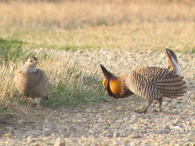Greater prairie chicken research leads to great award
Monday, Oct. 27, 2014
MANHATTAN — A Kansas State University professor is part of a group of researchers receiving a national award for the best journal article from The Wildlife Society for research on greater prairie chicken population declines that may change conservation practices.
Brett Sandercock, Kansas State University professor of wildlife ecology, and his colleagues, wrote the award-winning article "Demography of Greater Prairie-Chickens: regional variation in vital rates, sensitivity values, and population dynamics." Sandercock's co-authors include two Kansas State University alumni, Lance McNew, assistant professor at Montana State University, and Andrew Gregory, assistant professor at Bowling Green State University; and Samantha Wisely, associate professor at the University of Florida.
The article, published in the Journal of Wildlife Management, investigates demographic mechanisms driving the population declines of greater prairie chickens at three sites in Kansas: one site in the Smoky Hills and two sites in the Flint Hills.
"A lot of wildlife agencies monitor prairie chickens by counting birds at leks, so they know population trends but they don't know what is driving the numbers," Sandercock said. "This research — one of the most comprehensive analyses of any grouse species — identifies that reproductive failure is driving the population declines."
The researchers did a complete demographic analysis, which included estimates of clutch size, nest survival, brood survival, juvenile survival and female survival, across two ecoregions and multiple years. According to Sandercock, prairie chickens have poor reproduction in managed grasslands, with an average productivity of one juvenile for every seven nesting females.
Their results suggest that the rate of population decline was sensitive to the patterns of landscape fragmentation and land use, and that the greater prairie chicken population would benefit from immigration and better productivity. The research also indicated that nest and brood survival were low because of land management practices and changes in predator numbers.
The article was written as part of McNew's dissertation while he was graduate student in the Division of Biology at Kansas State University. The award was presented at the society's annual conference Oct. 25-30 in Pittsburg, Pennsylvania.
The Wildlife Society presents annual awards in four categories: best journal article, the best monograph, best book and best edited volume. The awards recognize publications with scientific writing featuring research or thought originality and a high scholastic standard of presentation. The article must be published within the last three years and must be research and management oriented.
"This is a highly prestigious award," Sandercock said. "The committee selects only one article per year. The award confirms that the work we are doing here at K-State is competitive at a national scale and among the best research in wildlife ecology."
The project was conducted on managed rangelands in Kansas.
"We are very grateful to landowners who permitted access to private lands for this field project," Sandercock said. "The work could not have been completed without their generous cooperation and support."
Research and equipment were sponsored by a consortium of federal and state wildlife agencies, conservation groups and wind energy partners under the National Wind Coordinating Collaborative, including the Department of Energy; National Renewable Energies Laboratory; U.S. Fish and Wildlife Service; Kansas Department of Wildlife, Parks and Tourism; Kansas Cooperative Fish and Wildlife Research Unit; National Fish and Wildlife Foundation; Kansas and Oklahoma chapters of The Nature Conservancy; BP Alternative Energy; FPL Energy; EDP Renewables North America, formerly Horizon Wind Energy; and Iberdrola Renewables.

